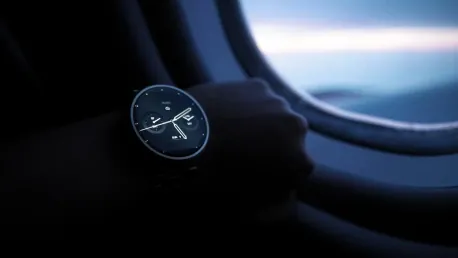As anticipation builds for the release of the Samsung Galaxy Watch 8 in the summer of 2025, technology enthusiasts and industry insiders eagerly speculate about the innovative features and upgrades that this next-generation smartwatch could bring to the market. The transition from OLED to MicroLED display is one of the most exciting rumored features, promising superior energy efficiency, resolution, brightness, and color saturation compared to current OLED technologies. In addition to the potential performance enhancements introduced by MicroLED, the expected redesign towards a more angular, square-ish case resembling the Samsung Galaxy Watch Ultra hints at a bold new direction in Samsung’s design philosophy. This shift may aim to offer a more clearly tech-forward aesthetic, drawing closer parallels to Apple’s wearables and setting the stage for a highly competitive market landscape.
Display Upgrades with MicroLED Technology
The shift from OLED to MicroLED technology in the Samsung Galaxy Watch 8 is expected to be a game-changer, offering improvements that could elevate the user experience to new heights. MicroLED displays are renowned for their superior energy efficiency, which could significantly extend the battery life of the smartwatch. Additionally, the increased resolution, brightness, and saturation provided by MicroLED panels promise clearer, more vibrant visuals that would enhance readability and overall visual appeal. These advancements are particularly crucial for outdoor use, where bright sunlight often impairs the readability of traditional OLED screens. By adopting MicroLED technology, Samsung could potentially address this common issue, providing users with a more reliable and enjoyable viewing experience in various lighting conditions.
Energy efficiency is another key advantage of MicroLED technology, as it consumes less power than OLED displays. This can be especially beneficial in extending the battery life of a smartwatch, which is a critical concern for many users. A longer battery life would allow users to go longer between charges, making the Samsung Galaxy Watch 8 a more convenient and reliable companion for daily activities. Furthermore, the improved durability of MicroLED panels could enhance the watch’s resilience against physical wear and tear, ensuring that the device remains functional and visually appealing over the long term. As Samsung continues to push the boundaries of display technology, the inclusion of MicroLED in their upcoming smartwatch could set a new standard for the industry and consolidate the company’s position as a leader in the market.
Innovative Designs and Potential Features
Beyond the anticipated display upgrades, the Samsung Galaxy Watch 8 is also rumored to feature a redesigned case that moves away from the traditional round form factor towards a more angular, square-ish design reminiscent of the Samsung Galaxy Watch Ultra. This design shift could signal a broader trend in Samsung’s smartwatch lineup, aiming to offer a more obviously tech-forward and modern aesthetic. The new design may also accommodate a larger screen, potentially providing users with more space for interacting with apps and notifications. This change might not only differentiate the Galaxy Watch 8 from its predecessors but also position it as a direct competitor to the Apple Watch series, known for its rectangular design.
One of the most eagerly anticipated features of the Galaxy Watch 8 is the potential introduction of non-invasive blood glucose monitoring. This capability could represent a significant breakthrough for individuals with diabetes or those looking to maintain better control over their blood sugar levels. While current smartwatch offerings often include heart rate monitoring, sleep tracking, and fitness tracking capabilities, the addition of blood glucose monitoring could provide Samsung with a competitive edge in the health and wellness space. Although there is still some speculation regarding the feasibility and accuracy of this technology, its successful implementation could profoundly impact users’ lives and set the Galaxy Watch 8 apart from other smartwatches on the market.
Addressing Battery Life and User Preferences
Amid the speculation surrounding the Galaxy Watch 8’s potential features, users have expressed a strong desire for improvements in battery life. The Google Pixel Watch 3, particularly its 45mm model with a 48-hour battery life, has set a high standard for competitors. To keep pace, Samsung may need to focus on optimizing the Galaxy Watch 8’s power consumption and battery capacity. Many users hope for longer battery performance that can comfortably last through multiple days of active use. Enhanced battery life would undoubtedly contribute to the watch’s overall convenience, reducing the frequency of charging and ensuring that users can rely on their device throughout their day.
Another aspect of user preference relates to the watch’s physical design, particularly the case size. Some enthusiasts are calling for a larger 46mm case to align with the Apple Watch 10 and stand out from Google’s 45mm XL model. A larger case could offer a more visually impactful display and a better interface for interacting with the device’s functions. Additionally, there is a nostalgic call for the return of the Classic-style clicky bezel. This feature was prized for its utility and the satisfying tactile feedback it provided during use. Incorporating these elements could enhance the user experience and appeal to a broader audience, blending modern advancements with well-loved classic features.
Balancing Innovation and Market Trends
Beyond the expected display updates, the Samsung Galaxy Watch 8 is rumored to feature a newly designed case, moving away from the traditional round shape to a more angular, square-like design similar to the Samsung Galaxy Watch Ultra. This shift in design could indicate a broader trend in Samsung’s smartwatch line, aiming for a more tech-centric and modern look. The new design might also support a larger screen, giving users more space for apps and notifications. This change could distinguish the Galaxy Watch 8 from its predecessors and position it as a strong competitor to the Apple Watch series, known for its rectangular look.
One of the most eagerly awaited features of the Galaxy Watch 8 is the potential addition of non-invasive blood glucose monitoring. This feature could be a major breakthrough for people with diabetes or those wanting to better manage their blood sugar levels. While current smartwatches offer heart rate monitoring, sleep tracking, and fitness tracking, adding blood glucose monitoring could give Samsung an edge in the health and wellness market. Though there is some uncertainty about the viability and accuracy of this technology, its successful integration could significantly impact users’ lives and set the Galaxy Watch 8 apart from other smartwatches.









